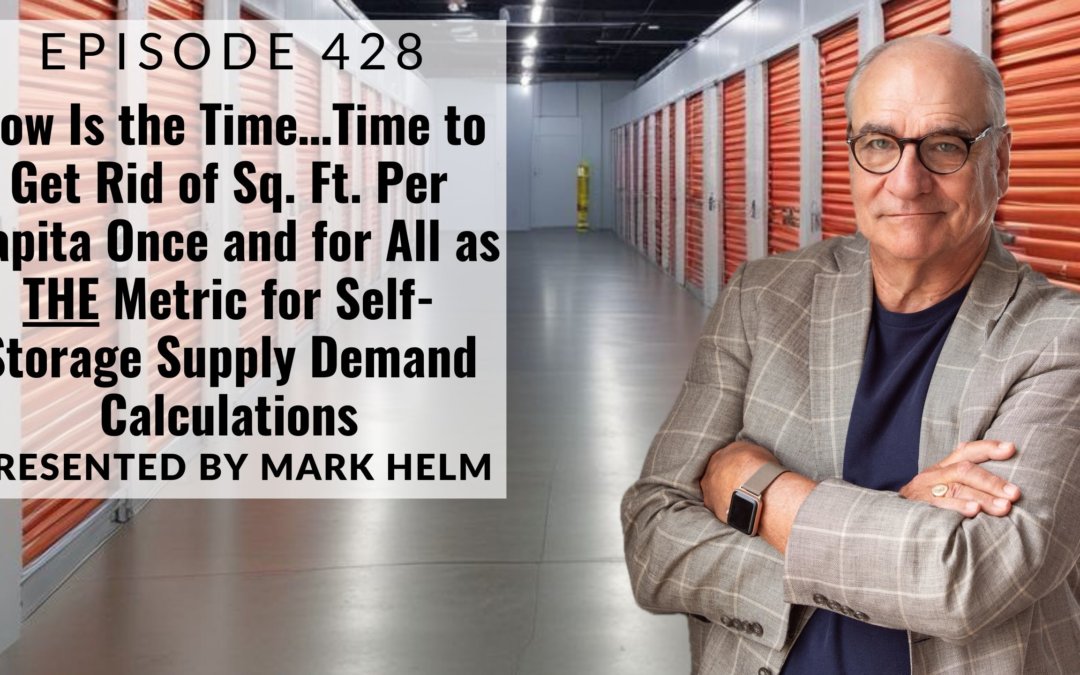It seems like once a year or so; I get on a soap box and rail about sq. ft. per capita as the primary measurement for self-storage supply demand calculations.
Just some of the episodes are:
- Episode 313 – 10-29-2021 Is Sq. Ft. Per Capita Still the Best Measurement for Self-Storage Supply/Demand Analysis?
- Episode 362 – 12-9-2022 – Supply and Demand Variables Besides Sq. Ft/ Per Capita – Is It Time to Revise Our Thinking?
There are a lot more episodes where I carry on about it.
Perhaps this will be the last.
It is time, in my humble (notice emphasis on humble) opinion, it’s time to kill it once and for all as the primary measurement.
It’s a bad one.
It’s not horrible, but certainly not the main determining factor.
I want to know it, but it is way down the line of relevant information today.
Why Now Is The Time
Now is the time because it can often be very misleading and generate completely false conclusions.
I noticed during these times that as interest rates are high and construction costs high, I had to look at a lot of factors to determine if a deal could work.
I paid a lot of attention to rental rates (actual rental rates, not necessarily what is posted on websites).
I realized beyond a shadow of a doubt, that it is rental rates and occupancy that define the supply/demand of a market, not sq. ft. per capata.
Now, I am no economist, but I have studied economics.
Prices, or in our case, rental rates, reflect the supply/demand for any given product.
If gas is in short supply, prices are high.
If there is a glut of corn on the market, corn prices are low.
No farmer looks at acres of corn per capita to tell them how much to plant.
Polo does not look at sweaters per capita to determine how many to produce. They look at what is selling and for how much.
OPEC or BP doesn’t look at gallons of gas per capita to tell them what production levels should be.
Wholesale beauty supply companies don’t look at beauty products per person to calculate production levels.
Why storage?
They study the prices and spending patterns of consumers.
In self-storage, I have seen markets where prices are strong, discounting is not the standard for all facilities, and occupancy appears to be good (i.e., waiting list for some units, not a lot of units available in certain sizes, etc.). These are the markets that have unmet demand.
I have recently received feasibility reports for some markets I have analyzed this way and put under contract.
To the credit of the person completing the report, they said, “by traditional metrics, the trade area appears to be oversaturated at 13 sq. ft per capita. However, rental rates are high and occupancy of the surrounding facilities is in the 90% or more range, so we have determined there is demand for more self-storage in the range of …”
Conclusion
I don’t know of any other business that utilizes “product per capita” to determine supply/demand.
In a capitalist economic system (there is a good argument that we don’t operate in a supply-driven system anymore, but I am going to ignore it for now), prices hold the most relevant information.
Today, I don’t give a damn about sq. ft. per capita.
If it is costing me $74 per sq. ft. to build a 10 x 10 (yes, we are building expansions and even two-story buildings in this range), in other words, $7,500 for that 10 x 10, and the rent is $65 per month, in other words, $780 per year, I am only getting 10.4% return on the construction cost. That doesn’t even include the land.
If a different facility in a different market charges $99 per month for a 10 x 10 and occupancy rates appear to be high, it’s a totally different dynamic.
Who cares if sq. ft. per capita is lower in the market with $65 210 x 10’s?
I have been focused on rates, and I realize that should have been my main driver all along.
I am making go, no-go decisions today in this world and almost totally ignoring sq. ft. per capita.
Interesting metric, but for me, it’s mostly irrelevant.
I say it’s time to get back to basic supply-side economics when analyzing self-storage supply/demand for a given area.
Let’s catch up with the rest of the mature industries.
Self-Storage is no longer an emerging sector. Our business is mature, so let’s act and measure the way other mature industries do.



